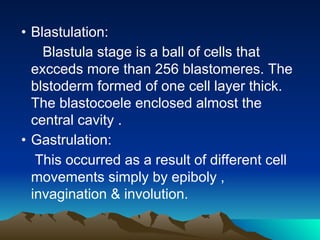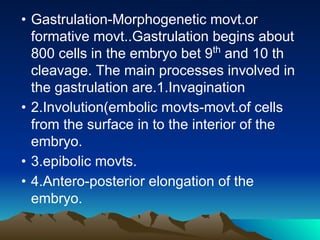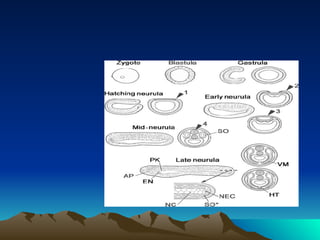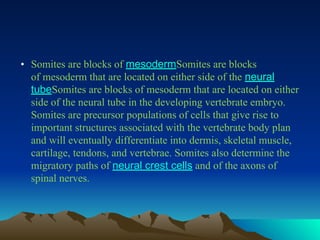Devpt of Amphioxus
- 1. University of Calicut Sixth Semester BSc Zoology Degree Programme Zoology Core Course XIII Theory Reproductive Biology, Developmental Biology and Teratology Course Code: ZO6B13T
- 2. Rahana Moideen Koya V.K MSc., MPhil, MEd, MA Assistant Professor Department of Zoology Farook College , Kozhikode rahanamoideenkoya@gmail.com Embryonic development of amphioxus
- 3. Amphioxus-Branchiostoma lanceolatum is a primitive marine chodate Suphylum –Cephalochodata It is oviparous,indirect devt.free living ciliated larva.early devt. Some similarity –Echinodermata same time vertebrate also.
- 5. Gonads-Sexes separate-no well marked sexual dimorphism. Testes and ovaries are located on both sides of the body bet body wall ,bordering the atrium and the muscle groups(myotomes).About28 pairs on each side Upon sexual maturity the sperms and ova are discharged into atrium by repture of body wall .then atriopore.to sea water. Ovum-0.01mm-0.12mm in diameter.nucleus towards one side of egg ,animal pole.outside plasma membrane thin mucopolysaccharides vitalline mem. Sperm-very small head middle piece,tail.head is spherical middle piece very short. V
- 7. Fertilization-External sea water. Female spawn through out summer and always towards evening ,while the animals are swimming.Males shed sperms into water near the female.One of these sperms penetrate vitelline membrane enters egg near the vegetal pole of the egg.As soon as sperm reaches into the egg the vitelline membrane is lifted off from the surface of of the egg to form fertilization membrane. The space bet.plasma membrane and fertilization membrane –Perivitelline space. Viscous fluid.
- 8. The entry of sperm into the egg stimulates the second maturation division release of second polar body. Which remains attached to to the animal pole in the perivitelline space.Sperm and egg nuclei enlarge to form male and female pronuclei.They migrate towards equator of the egg and fuse to form zygote nucleus.fusion of pronuclei slightly above the equatorial plane of egg
- 9. Embryonic development of amphioxus 1. Fertilization : External. 2. Types of Egg: According to amount of yolk oligolecithal. According to distribution ; homolecithal. 3. Types of cleavage: Equal holoblastic cleavage.
- 10. Cleavage
- 12. Meridional-Bisects both poles,through animal vegetal axisof egg .
- 14. Cleavage-Holoblastic almost equal. First.Meridional 60-90 min,after fertilization.animal to vegetal pole. Second-45 min.after first.meridional right angles to first. Third-30 min.after second.divide 4 blastomeres in the latitudinal (horizontal)plane at right angles to the first two cleavage furrows. 8 blastomeres..But it is slightly above the equator .So macro-micromeres .
- 15. • Fourth cleavage-Meridional and is double cleavage. Ie.two in number ,and the furrows pass from the animal pole to the vegetal pole at right angles to each other to form 16 blastomeres. •
- 16. Gradually cleavage becomes irregular micromeres divide more rapidly ,the synchronous character of the division declines and increase in no of blastomeres become arithmetical than geometrical.
- 18. • Blastulation-As the cleavage proceeds more and more blastomeres are produced and semifluid material accumulate in the centre of mass of cells.this serves to push all the blastomeres outward,so that they become arranged in single layer called blastoderm ,central cavity blastocoel.fluid or jelly inside. 200 cells when fully formed.which are arranged in the form of columnar epithelium around the the blastocoel.the cells at vegetal pole are larger.coeloblastula.
- 19. • Blastulation: Blastula stage is a ball of cells that excceds more than 256 blastomeres. The blstoderm formed of one cell layer thick. The blastocoele enclosed almost the central cavity . • Gastrulation: This occurred as a result of different cell movements simply by epiboly , invagination & involution.
- 20. • Gastrulation-Morphogenetic movt.or formative movt..Gastrulation begins about 800 cells in the embryo bet 9th and 10 th cleavage. The main processes involved in the gastrulation are.1.Invagination • 2.Involution(embolic movts-movt.of cells from the surface in to the interior of the embryo. • 3.epibolic movts. • 4.Antero-posterior elongation of the embryo.
- 21. • Invgination-Flattening of the blastoderm at the vegetal pole • The endodermal plate gradually invaginate or bend inwards into the blastocoel –so the embryo bome cup shaped with a large cavity. The new cavity –archenteron opens to ext.by blastopore. • The cup shaped embryo is double walled –ext.lining consists of presumptive epidermis and presumptive Ns named as ectoderm • Internal layer –mesoderm and endoderm ,both of these layers remain continuous with other over the rim of the gastrula. • The circular rim of the blastopore is called the lip. • The prospective notochord lies in the dorsal lip and the prospective mesoderm lies in the ventral lip.
- 22. • Involution-Along with the invagination of the endodermal plate the prospective notochord and mesodermal material from the rim of the cup shaped embryo involute (rolling over of cells from the surface in to the interior of the embryo.)into the interior of the gastrula.Blastopore is very broad in its initial stage.soon become contract reduced.As more material is shifted from the surface to the interior of the gastrula ,endoderm comes into contact with the opposite epidermal wall by replacing the blastocoel by the new cavity ,the archenteron.
- 23. • Epiboly-Deals with the movt. Of ectodermal cells over the surface of the embryo.Initially blastopore is a wide and roughly triangular opening and the ventrolateral lips of the blastopore tend to become continuous.They begin to grow dorsally and the dorsal lip become arched. The blastopore becomes an oval aperture. • Its dorsolateral and ventrolateral lips grow towards one another and blastopore becomes circular.Oval blastopore becomes small circular opening.
- 24. • Antero-posterior elongation of the embryo- • After constriction of the rim of blastopore ,the gastrula exhibit a general elongation in the ant-post direction . All the presumptive areas participate in elongation. Externally the neural ectoderm lies in the mid dorsal line above the notochord and epidermal ectoderm occupies the remainder. The notochordal cells form a long median band just below the neurectoderm .The lateral horns of the mesoderm crescent converge towards the dorsal side of the embryo and come to lie on both sides of the presumptive notochord .The gastrula now consists of Outer epiblast consisting of neural and epidermal ectoderm and an inner hypoblast comprising prospective notochord,mesoderm &endoderm.
- 29. Blastula
- 30. Gastrulation
- 34. • Neurulation—Formation of neural tube.The prospective neural ectoderm lying on the middorsal line of gastrula.These neural ectodermal cells become separated from the cells of epidermal ectoderm in the form of an elongated plate called neural plate or medullary plate.This plate gradually sinks and gets separated from the epidermal ectoderm.
- 44. • Diagram of amphioxus embryology. The gastrula and neurula stages are shown in side and cross-sectional views (left and right of each pair, respectively). The broken line on the side view of the late-neurula stage indicates the level of the frontal section (marked by the arrow). Arrowheads 1–3 show migration of the non-neural ectoderm across the neuroectoderm (first phase of neurulation), and arrowheads 3 and 4 indicate the curling up of the neural plate into the neural tube (second phase of neurulation). During the mid-neurula stage, somites (SO) and notochord (stippled) arise from the gut by evagination and upfolding, respectively. For the late-neurula stage, the approximate positions of the endostyle (EN), pronephric kidney (PN), and rudiment of the possible adenohypophysis (AP) are indicated near the anterior end; the frontal section of the tail-bud region shows the notochord (NC), the neurenteric canal (NEC), and a nascent somite (SO*); the cross sections show the ventral mesoderm (VM) evaginating down from the somites and the formation of the heart tube (HT) midventrally between the gut and the visceral mesothelium. •
- 45. • Somites are blocks of mesodermSomites are blocks of mesoderm that are located on either side of the neural tubeSomites are blocks of mesoderm that are located on either side of the neural tube in the developing vertebrate embryo. Somites are precursor populations of cells that give rise to important structures associated with the vertebrate body plan and will eventually differentiate into dermis, skeletal muscle, cartilage, tendons, and vertebrae. Somites also determine the migratory paths of neural crest cells and of the axons of spinal nerves.
- 46. • Neural crest cells (NCC) are multipotent cells induced at the border of the neural plate that subsequently migrate throughout the embryo and later differentiate into multiple cell types contributing to most of the peripheral nervous system and the cranio-facial cartilage and bones, as well as pigment and endocrine cells.













































